Issus (333 BCE)
Q201526Battle of Issus (5 or 6 November 333 BCE): famous battle during the war between Macedonia and the Persian Empire. The Macedonian king Alexander the Great defeated Darius III Codomannus, won Phoenicia and Egypt, and destroyed the Persian army.
Context
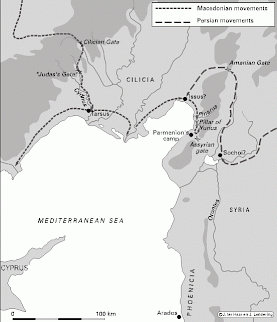
Since 340 BCE, a clash between Macedonia and the Persian Empire was inevitable. In that year, the Macedonian king Philip laid siege to Perinthus, threatening the vital interests of Greece and Persia (clear transit through the Bosphorus and Hellespont). The Persians responded by sending troops to Europe.note It was for the first time since Xerxes that the Persians intervened in the west, and the Macedonians considered this to be an unforgivable act of aggression. Philip first secured his rear; having provoked the Fourth Sacred War, he defeated the Greeks at Chaeronea (338) and forced them into the Corinthian League. Now, he was ready to strike east.
At about the same time, the Persian king Artaxerxes III Ochus died, leaving the Persian Empire without strong successor. His son Artaxerxes IV Arses had to cope with revolts in Babylonia (Nidin-Bel), Egypt (Chababash), and Armenia (Artašata). For the Macedonians, everything was now ready for the attack - except that king Philip was assassinated in 336 (more...), more or less contemporary with the death of Arses and the accession of Artašata, who became known as Darius III Codomannus.

In 334, Philip's son and successor Alexander invaded Asia, which was still poorly defended because of the Persian civil war. He defeated the local levies at the Granicus, which enabled him to conquer Anatolia. The only Persian force to offer resistance was the navy, commanded by Memnon and Pharnabazus, which consisted of Phoenician ships. To defeat the navy, the Macedonians decided to attack the Phoenician ports. In the autumn of 333 BCE, they entered Cilicia through the Cilician Gate.
Preliminary Movements
Darius had expected the attack and was already building an army. Part of the troops that were on the ships in the Aegean, mostly Greek mercenaries, were recalled to Syria, where these soldiers had to join the main force, which marched from Babylonia to Syria along the Euphrates. (It is a tribute to Darius' talents as an organizer that the grain prices did not explode during the army's stay in Babylon; when Alexander's troops were in that city, food prices were sky high.)
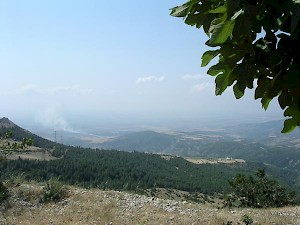
Darius' plan was ambitious. He wanted to build up a very large force to defeat the Macedonians on the plains of Cilicia or northern Syria, and, after his victory, use his fleet to invade the Aegean again, and cut off Alexander's line of retreat. The great king waited for the Macedonians on the plain of Sochi north of the river Orontes, east of the Amanus Mountains. Here, he learned that a Macedonian army had occupied the "Assyrian Gate" or Belen Pass.
The Macedonian force was commanded by Alexander's right-hand man Parmenion, who had occupied the site that is now known as Iskenderun. After reaching the capital of Cilicia, Tarsus, the Macedonian army had been divided: Alexander had attacked the mountain tribes of Rough Cilicia, opening a new line of communication, while Parmenion had occupied the Assyrian Gate to prevent a Persian invasion of Cilicia. When his scouts climbed to the pass, they saw the Persian army, and Parmenion sent messengers to Alexander, asking him to hurry to join him.
When Darius must realized that not all Macedonians were on the other side of the Amanus Mountains, he decided to use the "Amanian Gate" or Bahçe Pass to cross the mountains and place his army between the two Macedonian armies at a town called Issus.
Date
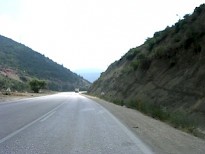
As the events at Gaugamela were to show, celestial omens played an important role in Persian warfare. If this is also true for Issus, it is very unlikely that Darius ordered his soldiers to march before the 27th of October, for which - according to the Astronomical Diaries - an eclipse had been predicted. Accepting normal marching distances, the Persians would have reached Issus after about ten days. The battle may have taken place on 5 or 6 November.
Macedonian Maneuvers
Parmenion had sent messengers to Alexander, who ordered forced marches, because he realized that the two armies, separated, would be vulnerable. When he reached Issus, he left behind the wounded and sick soldiers (Cilicia used to be a malaria area), continued to the south, and reached the hill now called Pillar of Yunus (where, according to a Muslim legend, the big fish put ashore the prophet Yunus/Jonah). In the afternoon, he was met by Parmenion. The united army counted about 41,000 infantry and 6,000 cavalry.
Shortly after Alexander and Parmenion had joined forces, they learned that the Persians were in their rear, at Issus, where they had killed the sick and wounded Macedonians. Alexander could not believe that the Persians, who were, according to the scouts, in the east, were actually in the north, but the report was confirmed by sailors who had seen thousands of camp fires south of Issus.
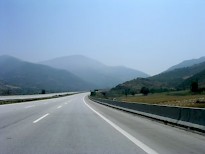
What had happened, was this: while Alexander, west of the Amanus Mountains, had been moving to the south, Darius, who had moved to the north on the eastern side of the mountain range, had used the Bahçe Pass to cross the Amanus. It was a mistake of the Macedonians not to guard this pass, but if they had, it would not have mattered much; the guards would have had no chance against the Persian main force, and Darius would still have reached Issus.
Darius will not have realized that the army to his south was the united Macedonian force. His scouts told him that the enemy was moving to the south, and the obvious conclusion was that it was trying to escape from the king's army. Believing he had succeeded in getting between the two Macedonian armies, Darius decided to use the next day to pursue the fleeing enemies; they would be defeated on the coastal strip between Issus and the Belen Pass, while the second army could be dealt with later.
Darius' Decision to Fight
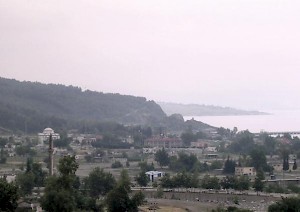
Next day the Persian king learned from frightened peasants that the Macedonian army was no longer moving to the south, but had in fact turned around to attack the Persians. At that moment, the king's army was already moving south, and it would be difficult to recall the 100,000 men. This meant that the battle would take place somewhere between the Pillar of Yunus and Issus. Although a coastal plain, this was hilly country, not very suited for Darius' army. Only the beach was suited for the cavalry maneuvers that were to bring victory to the Persians.
But the king of kings had no alternative. The best Darius could do, was find a suitable place to take up a defensive position. Fifteen kilometer south of Issus was the river Pinarus, which offered exactly what he needed: if he placed his infantry on its northern bank, the superior Macedonian phalanx would have to wade through the river and lose coherence. The fact that it had been raining was a great advantage to the Persians: the banks were slippery. This position would give the Persian infantry a fair chance to keep their lines intact until the superior Persian cavalry, on the beach, would have broken through the Macedonian lines, and could attack the Macedonian phalanx from the rear.
Battle Arrangements
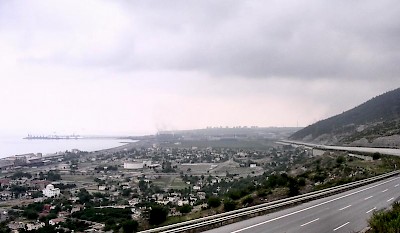
Before sunset, the Macedonians had left the Pillar of Yunus, and they were now moving north. It was about twelve kilometer to the Pinarus, and the Macedonians descended slowly. The Persians may have heard the frightening sound of thousands and thousands of Macedonian hoplite panoplies. Sometimes, the Macedonians halted, to make sure that their battalions were in one straight line. The terrain was gradually becoming wider, and the battalions had to deploy themselves accordingly. All this took some time, but in the end, the Macedonians were ready to cross the Pinarus.

Alexander and Parmenion knew that the superior Persian cavalry, which had all the space it needed on the beach, would break through the Macedonian lines, and decided to put their Greek hoplites in a second line, which could, at least for some time, slow down the Persian horsemen. This would gain sufficient time to allow the Macedonian phalanx to cross the Pinarus, and attack the Greek mercenaries in the Persian center. At the same time, Alexander posted his best cavalry, the Companions, on his right wing; they would charge at the Persian left wing and destabilize it.
While Alexander's men were approaching, a Persian unit that was still on the south bank to offer protection to those troops that were creating a defensive line on the north bank, was cut off from its main force. It fled to the mountains. The Macedonians believed that it was there to attack their right wing, and Alexander ordered some light armed troops to neutralize it, but the Persian unit did not attack.
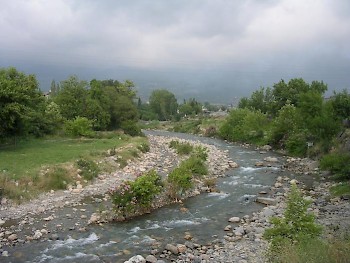
On the other bank of the Pinarus, Darius and his guard occupied the center. To his left and right were Greek mercenaries, and on the wings were kardakes, which appear to have been some sort of light-armed Persian phalanx. Darius had not much confidence in these troops, and put archers in front of them, to protect them against the Macedonian phalanx. Light armed troops probably formed a second line (they are mentioned in the catalog of troops at Issus, but are not mentioned during the fights).